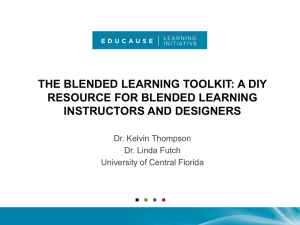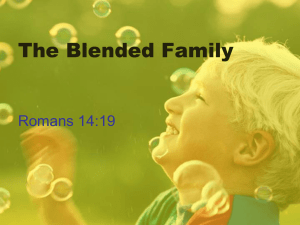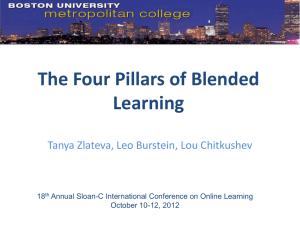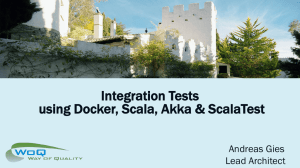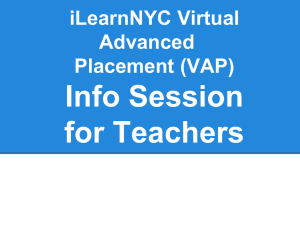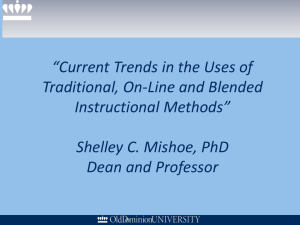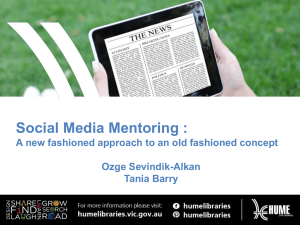Blended Learning at the University of Central Florida
advertisement
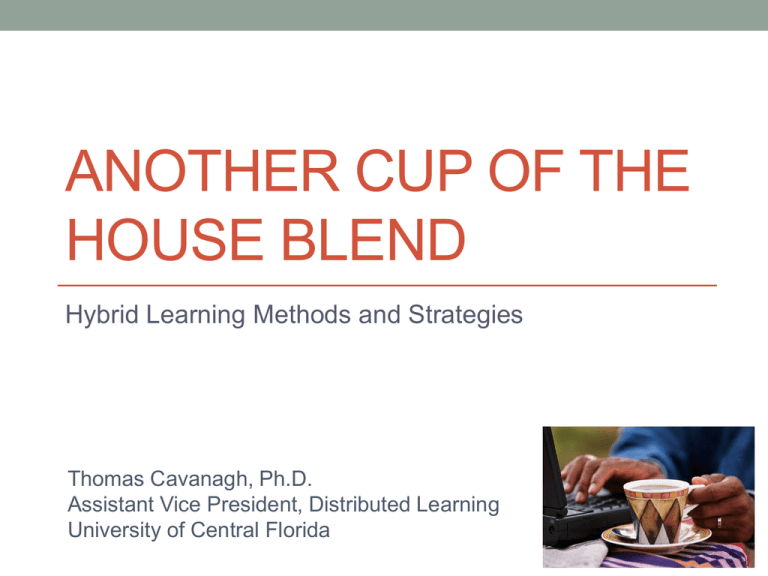
ANOTHER CUP OF THE HOUSE BLEND Hybrid Learning Methods and Strategies Thomas Cavanagh, Ph.D. Assistant Vice President, Distributed Learning University of Central Florida Margaret Single mother Coming back to college Dropped out during first college experience Works as a waitress at a chain restaurant Wants a degree to get a better job in Health Science Arthur High School Math Teacher Pursuing Master’s Degree Limited time for education Family, grading, Wrestling coach Wants a degree to advance in career Carol Full-time nurse Limited time for education: shift work Only one day per week Available for class Wants a BSN degree to advance in career Jared Full-time student Works part time Plays intramural sports Member of a fraternity Student loan debt Wants course flexibility to engage more in the on campus experience Common Thread • Flexible • Convenient • Accommodating • Quality • Workforce-oriented Next Generation Learning Challenges • 4 Challenge Areas • Blended Learning • Analytics • OER • Deeper Engagement • Under 26, low-income • Jared and the younger Margaret The UCF-AASCU NGLC Project • To scale the UCF model of blended learning across the AASCU network of institutions (and beyond). About UCF • Orlando, FL • Metropolitan, suburban • • • • • university 58,000+ students 2nd largest university in U.S. Carnegie classification: RU/VH Research University: Very High Research Activity 216 degree programs across 11 colleges 11 Campuses throughout Central Florida • Center for Distributed Learning • Over 30% of university SCH is online • Over half of all UCF students take at least 1 online course each year. • Fully Online Programs • 5 Undergraduate • 25 Graduate Degree • 29 Graduate Certificates Defining Blended Learning Classes where a portion of the traditional face-to-face instruction is replaced by web-based online learning. Fully Online Fully F2F Blended Learning Why Blended Learning? • Engage faculty in online learning • First step • Reduce delivery costs • Maximize facility use • Increase flexibility and convenience • Improve student learning outcomes • Expand access to education Strategic Alignment WebEnhanced Faculty Initiative Blended Learning Fully Online Institutional Initiative Levels of Blended Learning Program Level (Localness): Courses offered completely online Completely face to face Main campus / regional campus Hybrid/mixed format Course Level (Modality) Temporal / spatial (classroom utilization) Temporal (reduce large class blocks to decrease fatigue and increase productivity) Synchronous distance Assignment Level Group collaboration Discussions Enhanced F2F Time Shifting • One day F2F, rest online • Tues / Thurs • Mon / Wed / Fri • Maximize facility usage • Long instructional block • One 5-hour block split in have • Reduces fatigue, improves quality experience Ways of Blending • Divide for quality (no loss of efficiency) 1 50 1 2 50 150 3 50 Ways of Blending • Aggregate for efficiency (no loss of quality) 1 50 2 50 3 50 1 150 Blended Learning at UCF • Began with an Online initiative in mid-90s • Quickly realized that 75% of students were local • Was the catalyst for the blended learning initiative • Center for Distributed Learning 1,700,000 Sources of UCF Student Credit Hour Growth 1,500,000 1,300,000 1,100,000 900,000 700,000 500,000 1995-96 2000-01 2005-06 2010-11 Blended Learning at UCF 500% growth in blended courses n Fully Online Courses n Blended Learning Courses Blended Learning at UCF Blended Learning Sections Registrations Student Credit Hours (SCH) 2009-2010 Academic Year 681 24,241 70,438 Totals since 2002 5,031 160,860 476,823 UCF Fall 2008 Headcount “Live” Main Campus Students 43,466 “Live” Rosen Campus Students 1,301 865 2,446 2.6% 1.7% 137 111 0.3% 0.2% 33,087 65.8% 7,127 14.2% 2,847 5.7% 363 0.7% 923 1.8% 1,436 2.9% 2,046 4.1% “Live” Regional Students 4,800 Web Students 11,514 UCF Fall 2009 Headcount “Live” Main Campus Students 45,988 “Live” Rosen Campus Students 827 782 2,531 1.6% 1.5% 204 697 0.4% 1.3% 33,988 63.5% 8,593 16.1% 375 0.7% 1,030 1,497 1.9% 2.8% 1,886 3.6% 3,637 6.8% “Live” Regional Students 4,809 Web Students 14,543 UCF Fall 2010 Headcount “Live” Main Campus Students 47,926 “Live” Rosen Campus Students 695 758 1.2% 2,472 1.4% 764 1.4% 34,059 60.6% 234 0.4% 10,363 18.4% 478 0.9% 1,490 2.7% 2,049 3.6% 4,113 7.3% 1,213 2.1% “Live” Regional Students 5,251 Web Students 17,172 Regional Campuses = Blended Learning Alignment with Regional Campuses Fully Online Blended Academic Year 2002-03 SCH % SCH % 22,801 27 5,711 7 2003-04 36,840 35 7,699 7 2004-05 33,690 35 7,159 7 2005-06 48,008 41 8,806 8 2006-07 57,393 44 9,946 8 2007-08 64,843 44 17,067 12 2008-09 74,561 46 10,847 7 2009-10 88,834 51 11,383 7 2010-11 116,508 55 13,481 6 2010-11 F2F = 31% SCH UCF Blended Programs = Choice and Access Fall 2010 Total UCF students Students in Face-to-Face (F2F) Web OR Blended F2F + Web F2F + Blended F2F + Web OR Blended F2F + Web + Blended Web Only 56,129 49,510 23,741 12,157 8,827 18,288 2,696 4,109 (Summer 2010: 6,459) Course Evaluation Ratings N = 672,185 Course Modality Blended % Overall “Excellent” 51.2% Fully Online 48.3% Face to Face 48.2% Lecture Capture (with classroom) 43.4% Lecture Capture (no classroom) 41.6% Student Success Rates by Modality F2F (n=618,899) 100 90 87 88 88 91 Blended (n=39,021) 95 88 87 91 Fully Online (n=109,421) 86 88 91 88 91 94 88 Percent 80 70 60 50 40 30 20 10 0 Spring 09 Summer 09 Fall 09 Spring 10 Summer 10 Withdrawal Rates by Modality 100 90 F2F (n=551,065) Percent 80 Fully Online (n=109,495) Blended (n=39,769) 70 60 50 40 30 20 10 4 4 5 3 2 4 3 3 4 3 3 5 2 1 4 0 Spring 09 Summer 09 Fall 09 Spring 10 Summer 10 Student Satisfaction in Fully Online and Blended Courses Percent Fully online (N = 1,526) Blended (N = 485) 39% 41% 38% 44% 9% 11% Very Satisfied Satisfied Neutral 9% 3% 5% 1% Very Unsatisfied Unsatisfied Faculty Willingness to Teach Web/Blended Courses in the Future Definitely Probably Probably not Definitely not Positive Neutral or negative 69% 81% 16% 10% 6% 13% 2% 4% Online n=71 Blended N=53 Modality Poll Question and Q&A 1 • Does your institution differentiate between fully online and blended? Can you tell blended from “web-enhanced”? • In general, how do you think your students would rate your online offerings? Your blended offerings? • Questions? THE NGLC PROJECT Expanding Blended Learning Through Tools and Campus Programs A UCF/AASCU Project Project Overview • Scale the proven UCF Blended Learning model via the national AASCU network of more than 420 institutions and systems • Starting with 20 targeted schools selected for their alignment with NGLC objectives (under 26, low income) Scale UCF Model of Blended Learning • Across 20 AASCU institutions and 11 states Partners Individual Institutions Columbus State University State Coordinating Institutions Missouri Fayetteville State University Grambling State University Northwestern State University (LA) Indiana University Kokomo Southeast Missouri State University Texas A&M University-Corpus Christi The College at Brockport, State University of New York Thomas Edison State College Alabama University of Maine at Fort Kent Winona State University Troy University Minnesota State Participating Institutions Harris-Stowe State University Lincoln University of Missouri Missouri Southern State University Missouri State University University of MissouriSt. Louis University of North Alabama University of South Alabama St. Cloud State University Project Administration Team • Principal Investigators • Tom Cavanagh, UCF • George Mehaffy, AASCU • John Hammang, AASCU • UCF: • Linda Futch • Patsy Moskal • Chuck Dziuban • Elizabeth Wardle • Debbie Weaver • Tammy Muhs • Kelvin Thompson Project Overview • An open educational resource (OER) Blended Learning Toolkit containing: • Best practices, strategies, models, and course design principles. • Two OER prototype courses in Composition and Algebra. • Directions for applying the toolkit to create original blended courses. • Train-the-trainer materials. • Assessment and data collection protocols, including survey instruments and standards. Project Overview • Virtual and in-person workshops for participating institutions and others within the AASCU membership. • Institutional support through existing AASCU meetings and conferences, which will align ongoing activities in technology and educational transformation with NGLC’s goals. • Clear access points for additional institution-funded blended courses, ensuring the toolkit materials are openly available. Project Overview (key measures) • 217 funded blended course sections across twenty project institutions: target delivery of at least 85% of those sections (185). • Targeted low-income students under age 26 (with the total population across the participating institutions being 187,500). NGLC Assessment Expectations • Outcome 1: Build a blended learning infrastructure across the network of participating AASCU member institutions. • 1-a. Identify participating institutions, communicate requirements, and gather necessary data on courses, demographics, and assessment capabilities. • 1-b. Develop the Blended Learning Toolkit materials and resources (including strategies, blended models, resources, and assessment protocols). • 1-c. Package prototype courses in Composition and Algebra. • 1-d. Conduct Train-the-Trainer sessions. NGLC Assessment Expectations • Outcome 2: Increased access to education via blended learning (20 AASCU member institutions; 185-217 funded individual courses) for low-income students under 26 years old. This is the most critical outcome because it correlates directly to NGLC’s stated priorities. • 2-a. Disseminate toolkit materials and prototype courses to state coordinating institutions and individual participating institutions. • 2-b. Implement courses across the AASCU network. • 2-c. Assess project success. NGLC Assessment Expectations • Outcome 3: Increased student success and increased student retention. • This is a supplemental measure external to the grant requirements but very much consistent with NGLC’s long-term goals. In order to support eventual increases in student success and student retention, we intend to build longitudinal data collection into the project design. This data will be collected during the grant period for later analysis and reporting. Original Delivery Plan by Discipline Discipline Fall 2011 Mathematics (Algebra) Sections Mathematics (Other) Sections English (Composition) Sections English (Other) Sections Miscellaneous Sections TOTALS 23 8 48 8 25 112 Winter/Spring 2012 23 8 38 15 21 105 Totals 46 16 86 23 46 217 Management Structure Composition • Coordinators: Elizabeth Wardle & Debbie Weaver • English Composition I: Expository writing with emphasis on effective communication/critical thinking. Emphasizes the writing process. • “Flexible Template” model • Prix Fixe or A la carte • 6-week online course for participating faculty to understand the blended format applied to the WAW curriculum. • Monthly webinars starting in Fall. Algebra • Coordinator: Tammy Muhs • College Algebra: Algebra skills: Inequalities, high degree polynomials, graphs, rational, logarithmic, and exponential functions, and systems of equations. • “Flexible Template” will allow for individualized customization. • One or more webinar sessions for participating faculty to understand the blended format applied to the modified emporium model of the Algebra curriculum. • Monthly webinars starting in Fall. Assessment • Coordinator: Patsy Moskal • IRB consultation • Assessment / Data Collection • Centralized online form • Student perception • Student success • Course retention/withdrawal Project Team Website • Central communications hub • Schedule • Contacts • Proposal documents • Meeting recordings archives • Discussions • Events Intellectual Property • Creative Commons • Attribution-NonCommercial-ShareAlike license (CC BY-NC-SA) • NOTE: Project materials produced by UCF/AASCU with NGLC funding will be “open.” However, the courses produced at each individual campus will be bound by their own institutional IP policies. Blended Learning Toolkit Now available: www.blendedlearningtoolkit.org BlendKit2011 • Designed and facilitated by Kelvin Thompson • Generic instruction on blended course design and delivery • 5 week Quasi-MOOC (facilitated for grant) • Began 7/11/11 • “Home Base”: http://bit.ly/blendkit2011 • Also accessible via the Blended Learning Toolkit under Faculty Development Project Milestones Milestone Proposed Deadline Project website May 20, 2011 Toolkit website July 1, 2011 Centralized online assessment form August 31, 2011 Composition course template July 1, 2011 Composition train-the-trainer Algebra course template Webinars/Training July1 - August 8, 2011 July 1, 2011 July 7 & August 4 General Blended Learning Training July 11 - August 15, 2011 Deliver blended courses Fall 2011 & Spring 2012 IRB requirements at institutions Ongoing Project status updates Periodic General project webinars Periodic Functional team webinars Monthly NGLC Quarterly Progress: Outcomes Quarterly progress 1 2 1a. Identify participating institutions and communicate requirements X X 1b. Develop Blended Learning Toolkit X X 1c. Package Composition and Algebra prototype courses X X 1d. Conduct Train the Trainer sessions X X Outcome 1: Build Blended Learning Infrastructure 2. Increased access to education via Blended Learning for low-income, under 26 students 2a. Disseminate toolkit materials and prototype courses to participating institutions X 2b. Implement courses across AASCU network * 2c. Assess project success. * 3. Increased student success and retention X=Completed, *=in progress 3 4 Partner Feedback Dr. Holly McSpadden Southeast Missouri State University Course: Composition Partner Feedback “I just completed watching the final webinar. Thank you for all your great work. The instruction, readings, content, activities, and presentation have been extremely beneficial… As mentioned in the webinar, I would welcome further training and opportunities to meet and collaborate.” Ann M. Giralico Pearlman, M.A. Instructional Design Specialist College at Brockport Partner Feedback “I missed the live session Mon. but the recorded session was great. I got some good ideas for my fall class from the week one readings which I had completed ahead of time as well as the week two readings which I have only surveyed so far. I like the style & format of the presentation and am looking fwd to be available for week 2 and getting to interact with other math folks. I have been able to distill my thoughts so far into 6 outcomes/goals for this fall's class. I'm eager to "try them out" with the group. Without your stimulus I would not be here yet. Thx for what you do.” Tom Goetz University of Main at Fort Kent Anonymous Feedback “The DIY tasks were extremely helpful, particularly the zapt features allowing me to turn my documents into html pages for my course web site. Thanks so much!” “I am VERY grateful that the content remains available online for repeat viewing. Now that I have the bare bones course up and running, I have more time to learn how to make the course better.” “I am currently participating in the Blendkit 2011 course and have gotten some great ideas to incorporate into my blended developmental writing course.” SRI Evaluation • Readiness for Scaling at Time of Site Visit: Moderate • Key: Strong = Ready to scale to proposed number of sites/students; detailed implementation plan including all necessary components in place. • Moderate = Progress toward scaling to proposed number of sites/students but not completely ready. • Limited = Less than expected progress toward scaling to proposed number of sites/students • Readiness to Demonstrate Effects at Time of Site Visit: Limited • Key: Strong = Experiment or controlled quasi-experiment planned using valid, reliable measures and monitoring sample attrition. • Moderate = Single-group pre/post testing or a quasi-experiment without statistical controls for selection bias planned OR a planned experimental or quasi-experimental design is flawed by small size and/or use of an outcome measure of limited relevance or validity. • Limited = No evaluation plan in place OR planned single-group pre/post testing or quasi-experiment without statistical controls with further flaws in terms of small size and/or use of an outcome measure of limited relevance or validity. SRI Evaluation • Team provided official response to evaluation • Criteria not in alignment with RFP or funded proposal • Scale is largest and we are on track to meet goals Questions? Follow Along… @tbcavanagh @Blendkit www.blendedlearningtoolkit.org
